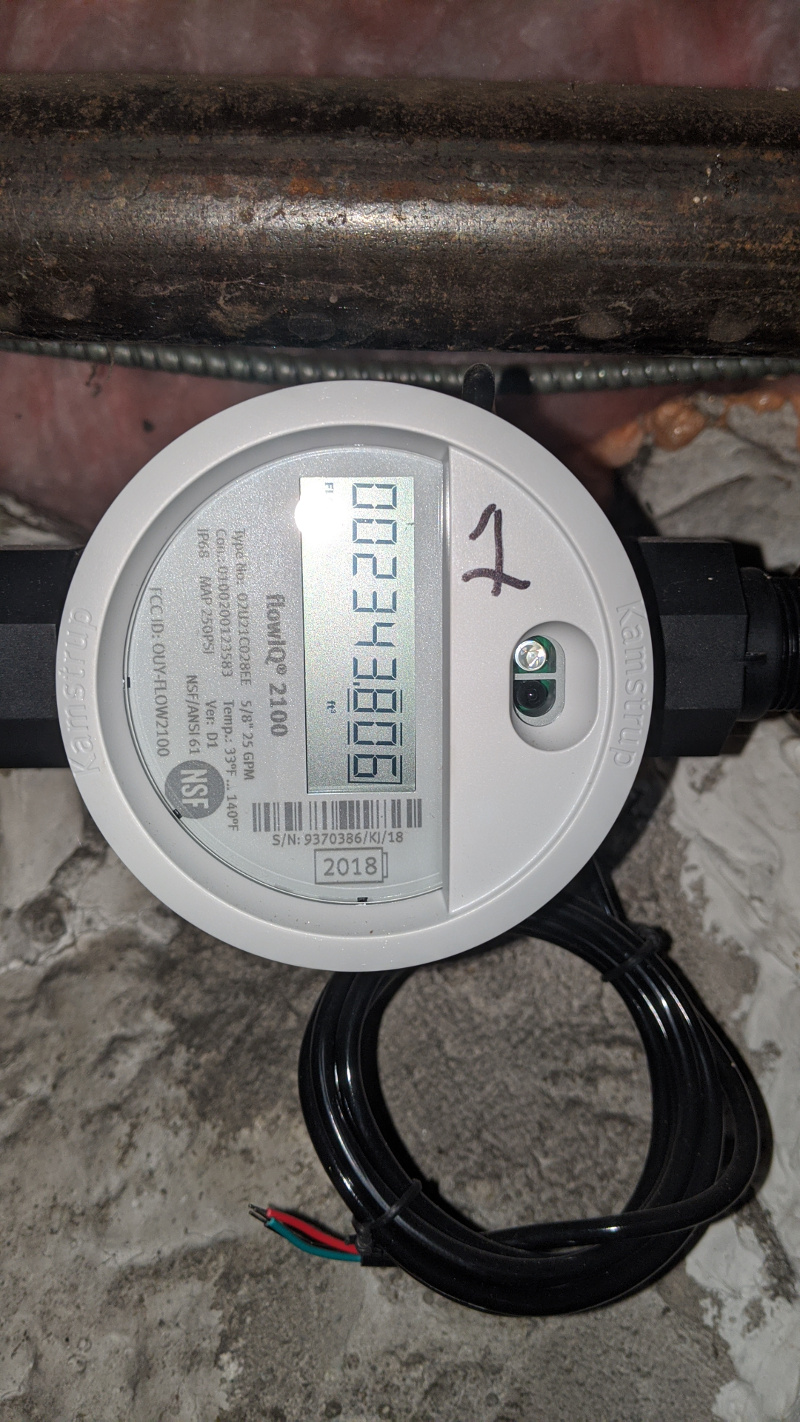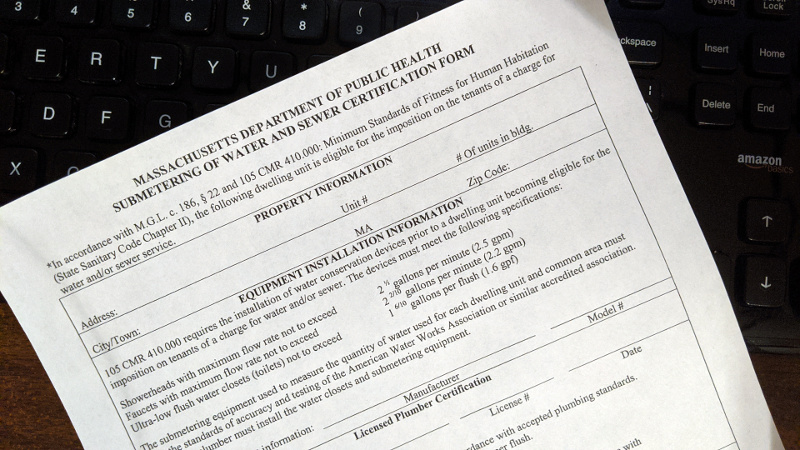Water Submetering
Water Submetering: Costs, Benefits and Legal Compliance
By Eric Weld, MassLandlords, Inc.
For some landlords in Massachusetts, water submetering might seem like a logical solution—especially those who have suffered through or heard about nightmare tenants who run up massive water bills or ignore major leaks.

A variety of water submeters are available, including wireless devices that can deliver data online.
In this all-too-common scenario, the water bill arrives and for some reason, without warning, you owe thousands of dollars. Without submeters monitoring each of your renters’ water usage, you have no idea which tenant is running up the bill, or even if it’s a collective problem among more than a single renter.
If you had installed water submeters you would quickly be able to check the meters and determine which unit used all that water, then take action.
Water submetering is the practice of installing water usage meters inline or at point-of-use for each rental in a multi-unit building behind the city’s (or water company’s) main water meter. It allows landlords to monitor the water usage of individual rental units in order to curtail waste and over-use, and in some cases—as the law allows—to charge renters individually for their water usage.
Utility submetering has been around since the 1920s but was not widespread until the energy crisis in the mid-1970s, which prompted an increase in submetering for gas and electric usage. Water submetering began its increase nationally in the mid-1990s when water and wastewater prices started rising. It has become standard practice to install submeters for many newly constructed multi-unit buildings.
Does it Make Sense?
There is no shortage of anecdotes among landlords about surprise multi-thousand dollar water bills and sudden exorbitant increases in usage.
But even aside from extreme scenarios, water submetering may make sense for landlords just seeking to improve efficiency, reduce water usage, and possibly pass on water charges directly to their tenants instead of building an estimated charge into the rental amount (or simply paying for tenants’ water). Tenants are more likely to self-monitor and reduce water usage when they know their landlord will see it, and certainly if they are paying for it themselves. Tenants are also more likely to report leaks under those circumstances—thus avoiding nightmare scenarios.
According to National Exemption Service (NES), a national submetering contractor, installing water submeters typically results in a reduction in water use of between 15 and 30 percent.
“Once tenants know they will potentially have to pay for the water, they become more cautious not to waste it,” said Harry Paul-Emile, a landlord in Framingham who installed water submeters for his rentals about 10 years ago when he noticed his water bill continually increasing without knowing why. “When I found out that I could separate each apartment, I jumped on the opportunity. I have not seen any craziness in terms of water usage since. For me it was worth it because it raises the level of awareness.”
For tenants’ part, too, some appreciate the transparency of seeing a monthly bill and paying for their water usage directly.

Massachusetts landlords must submit a completed form to the local health department in order to install submeters for the purpose of charging tenants for water usage and/or sewer service.
Price Range
While installing water submeters can potentially save landlords thousands of dollars, it does require an upfront investment that can be substantial. First, there’s the purchase of submeter devices. Quality submeters such as those made by Neptune, a popular brand, which are made of brass and contain intricate mechanical workings, can run north of $200 each. (Stainless steel meters are available for less but are not widely recommended by plumbers because they don’t typically last as long.)
Cost is also determined by the technology included with the meter. There is a range of reading options, from manual on-site readings to smart meters with wireless capability that can send online readings, provide analytics and optimization.
Add in the cost of conservation measures such as buying and installing low-flow water fixtures in each rental, required by law since 1994. (See related, Water Submetering: Requirements and Step-by-Step Instructions, for specifics.)
Then there are plumbers’ fees, which, depending on the configuration of your rental property could run into the multi-thousands to run new plumbing to each unit. Consider, for example, the typical three-decker, ubiquitous throughout Worcester and Suffolk Counties. Cold water is usually supplied to each unit via one vertical supply line. Accessing the plumbing in order to run dedicated water lines to each unit could require costly renovation to open up walls, followed by plaster or drywall replacement and repainting.
By the time you spend up to $12,000 to submeter a triple-decker, with a typical water bill running about $350 per quarter, your payback for all submetering costs could take more than eight years.
For such scenarios, water submetering is not an easy call even if you include a few surprise thousand-dollar water bills here and there.
Not Only About Money
Beyond the finances, landlords also must consider the added time they will now have to allow for taking readings. That means physically checking each meter you’ve installed once a month, or at least installing a camera pointed at the meter for remote readings. If that’s your setup, make sure to place it in adequate lighting for camera visibility, or install a timed lamp, too.
Smart meters that are able to send usage data to your phone or other Wi-Fi device can be a big time saver. But no matter what data reporting system you use, you’ll spend time recording meter readings, calculating costs and writing and delivering invoices to tenants.
When doing so, you’ll need to consider measurement units. The city’s meter might measure in 100 cubic foot units, for example, while the submeter you purchased may measure in gallons. In order to bill accurately by the month, you will need to calculate the equivalent usages between these different measuring units and bill accordingly.
MassLandlords in November made available to members a customizable rent invoice including a section for water billing for submetered units.
The good news for landlords who would like to submeter but don’t have the time or inclination for setting it up is that there are numerous outsourcing options in today’s market—contractors that specialize in submetering and can take care of every aspect of the job, from installation to reading and billing. Such service, of course, comes at a cost somewhere above the DIY route.
Water Submetering Law
Still, cost aside, the bigger obstacle to installing water submeters for many landlords in Massachusetts is the state law. Utility submetering laws vary widely from state to state, and more than half of all U.S. states have no laws regulating submetering. In comparison with most other states, the Massachusetts law (see M.G.L. c. 186, §§ 22) is a relatively stringent set of regulations.
Massachusetts landlords must meet several criteria in order to charge tenants for submetered water usage, including: hiring a licensed plumber to install meters; including the intention of charging tenants for water in the rental lease; using or installing low-flow faucets and showerheads in bathrooms, faucets in kitchens and low-flush toilets; and, importantly, only starting with a new tenant (i.e. charging for water cannot be imposed on an existing tenant mid-lease or otherwise, and a tenant may not be forcefully removed from a rental for the purpose of beginning water billing on a new tenant). Submeters must be installed behind, and be subordinate to, a main meter monitored by the water provider. Landlords may only charge tenants for water used by them and in their units exclusively; no charge may be levied for water usages in common areas shared by more than one tenant. Finally, you must have approval from the local Board of Health for the install.
One bright point is that the Massachusetts legal regulations also apply to wastewater or sewer service charges. So if sewer is billed as a percentage of submetered water, the cost of sewer can also be sub-billed to renters.
Submetering Solutions
For Paul-Emile and others—particularly landlords starting fresh leases in new rentals—the payoff from installing water submeters is worth the costs in materials, time, labor and legal compliance. The transparency, for them and their tenants, of knowing exactly how much water is being used per unit, promotes a better, more trustful tenant-landlord relationship while helping to reduce water waste.
Finally, the tight Massachusetts state law only applies to landlords who want to charge their tenants directly for their water usage. For landlords only interested in monitoring and potentially reducing water usage—without directly charging renters for water—there is nothing in the state law that restricts installation of water submeters at any time.
And by doing so, you might just avoid a nightmare scenario down the road.
Water Submetering: Requirements and Step-by-Step Instructions
In Massachusetts, the Landlord Pays for Water and Sewer Unless:
- Water is submetered for the premises under the renter’s exclusive control;
- Water conservation devices are on all showers, faucets, and toilets;
- Water submetering has been agreed to in writing;
- You have filed with the local municipality, under pains and penalties of perjury, that you’re in compliance, and this has been attested to by a licensed plumber;
- You provide a copy of the submetering filing to the occupants, AND
- You provide access for the renter to inspect the submeter.
Requirements
Low flow devices
- Low-flow showerhead max 2.5 gpm (gallons per minute)
- Low-flow faucets max 2.2 gpm (gallons per minute)
- Ultra-low-flush toilet max 1.6 gpf (gallons per flush)
Submetering equipment
- Must be installed by a licensed plumber
- Must be in compliance with the standards of accuracy and testing referenced in subsection (b)
- Must be at the expense of the landlord
- Submetered units must be in compliance with the board of health
Qualified tenancies
- Upon the commencement of a new tenancy in such dwelling unit and only if:
- the dwelling unit is being occupied for the first time; or
- the previous tenant was NOT evicted without cause
- the new tenant was NOT relocated involuntarily from another dwelling unit in the same building or building complex;
- Tenant has signed a written rental with the details of the water submetering and billing arrangement between the landlord and the tenant, billed according to subsection (f)
- (s) No public housing
Other
- (l) A landlord may not shut off or refuse water service to a tenant on the basis that the tenant has not paid a separately assessed submetered water usage charge.
- (o) Landlord must rebate tenant if there is a plumbing leak
Step-by-Step Instructions
- Contact multiple plumbers to get quotes.
- Indicate that you know and are prepared to pay for the cost (because most plumbers will think you're crazy).
- Discuss options for retrofitting as cost effectively as possible (see above).
- Have the plumber pull permits for the work.
- Contact the city to get the form they want you to complete (usually a state form but may have been modified).
- Have the plumber fill out the form.
- You both sign it.
- Mail it to the city/town.
- Learn to use the monthly rent invoice/water bill form.
- Modify your rental agreement to contain a submetering clause and a space to write the meter reading into it at lease start.
- Incorporate the municipal submetering form in the agreement.
Related Pages:
Identify and curtail waste by submetering with pro tips from others who have done this before.




